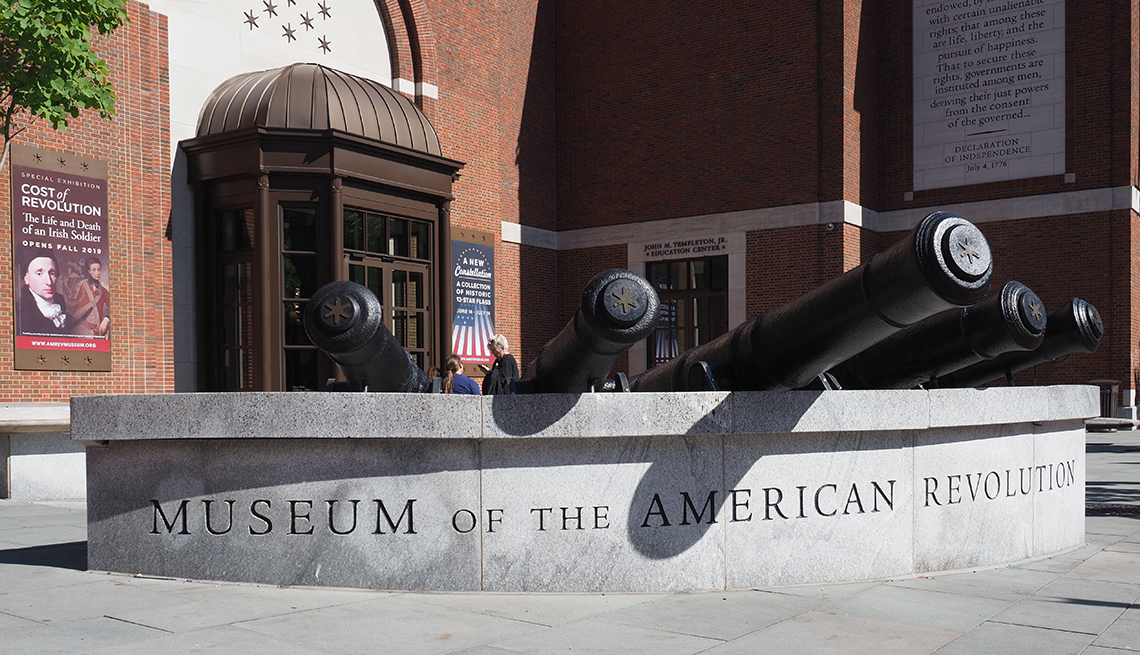Play all audios:
Storm clouds threaten the sunny skies over lower Manhattan as a crowd surges against a pedestal bearing a statue of a man on a horse. Curious, you pause, then inch closer. You hear voices
rising in anger. What’s going on? You notice several men tugging on the ropes they’ve lassoed around the animal and its rider. The bronze horse begins to rock back and forth, gently at
first, then more vigorously. “Tear that down!” someone shouts. A giant thud indicates sudden success. Thunderous drumbeats punctuate the victory. The tumultuous toppling depicted in this
video may seem relevant to our times, but it’s July 9, 1776, and the statue is not of a Civil War general but of England's King George III. This reenactment of an incident sparked by
one of the first public readings of the newly adopted Declaration of Independence serves as the opening salvo for the core exhibition of Philadelphia’s Museum of the American Revolution
(MAR). It poses the central question that sets the stage for the rest of your visit: How do ordinary people reach the brink, the tipping point, that turns them into revolutionaries?
Situated in the midst of many of the buildings in which the founding fathers laid out the principles that would guide a new republic, the museum fills a long-recognized gap by exploring how
the colonists arrived at that place in history. “Our historic neighborhood is like a piece of jewelry,” says R. Scott Stephenson, the museum’s president and CEO. “There are all of these
disparate precious stones — there’s Independence Hall and Christ Church and the First Bank — and we act as the setting for the piece. We’re what connects and intertwines those gems to make a
beautiful whole.” ARTIFACTS APLENTY COVID-19 UPDATE: You'll need to purchase timed-entry tickets, preferably in advance online. Face coverings are required for staff and all
visitors older than 5. The Battlefield Theater and Revolution Place, a discovery center for children, are closed. Guided tours are limited to five guests per tour. Check the museum's
website for its latest health and safety measures. The MAR opened four years ago as an expansion and re-envisioning of a much smaller collection that resided for decades at Valley Forge,
not far from the city. Inside its sprawling neo-Georgian building are thousands of artifacts contributing to the backstory of why the colonists eventually grew so dissatisfied with English
rule. Items from the mid-18th century, such as a cast-iron fireplace fireback and a tall grandfather clock, sporting royal emblems and commemorating British heroes, offer evidence of the
allegiance initially felt by the colonists for the mother country. But by the mid-1760s, the relationship had changed and the objects on display reflect that. Britain had acquired more land
and passed the Stamp Act — which imposed a tax on paper documents such as the newspaper showcased in one glass case — to raise money so it could “protect” its ever-expanding territory. You
begin to understand the resentment that’s about to roil over. And you know what happens next. The phrase that becomes a central rallying cry is evoked: _No taxation without representation!_
As you move through the exhibits you find yourself in Boston, where the resistance is fomenting. In the gallery’s center, a stylized re-creation of an elm that was known as the Liberty Tree
reaches up to the rafters. Liberty trees served as symbols and gathering places for burgeoning revolutionaries. Go ahead and slide your hand across a cutout in this massive prop. It exposes
an actual fragment of wood salvaged from a 400-year-old tulip poplar — the last surviving Liberty Tree — that stood in Annapolis, Maryland, until 1999. Soon, the “shot heard around the
world” is fired in the battles of Lexington and Concord, just outside of Boston, and the colonists are at war with Britain. Several types of weaponry used that April day in 1775 are
displayed, including an American-made bird-hunting gun and a powder horn, objects that forge a link with their owners to flesh out their stories. VARIED CAST OF PARTICIPANTS “Our
unofficial tagline is ‘you don’t know the half of it,’” says Stephenson, “and for us that means broadening the story’s scope to include a very diverse cast of characters.” So, yes, you’ll
venture through deadly battles and take deep dives into the crafting of the Declaration of Independence. You'll find yourself reliving the era’s familiar adages and actions — and
encountering the iconic heroes responsible for them. Some tea is dumped in a harbor, the times try men’s souls, without liberty one man will choose death.

